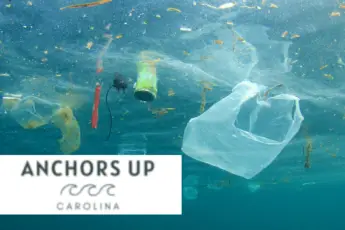One of the most unique looking knots in the nautical world is a monkeys fist, otherwise known as a monkeys paw. As a former captain, I have used this type of knot on a routine basis. Conversely, I also have a decorative monkeys paw on display at my home. Here is what you need to know about monkey’s fists.
What Is a Monkeys Paw Made From
When it comes to materials, a monkey’s paw is most often made from a dacron rope. The rope selection is important because the knot is subject to wear and tear from being tossed from a vessel to the dock below.
Notably, dacron rope provides superb grip and is incredibly soft on the hands. Additionally, it is highly resistant to abrasion despite its lightweight construction.
The knot is round in shape. In order to maintain the round appearance, a ball is placed in the center of the weaves. Importantly, the ball is lightweight because the dacron provides enough weight to heave effectively.
What Is The Purpose Of A Monkeys Fist
As a captain on yachts, monkeys paws were brought to use whenever we returned to the dock after being at sea.
In the line locker of the boat, we hung four monkey’s paws so they could be readily available when needed. Four were on hand in the event that the heaving knot was needed on the bow and the stern. Understand the functionality of the heaving knot.
The Knot
On the top of the heaving line is the monkey’s fist. The knot on the end is typically small in size. Remember, the fist is held and tossed from the vessel to someone standing by below on a dock.
Without question, it would be challenging to manipulate a massive monkey’s paw compared to something that can be held by hand.
The Trailing Line
Beneath the fist is the trailing line. The length of the line is highly variable depending on the size of the vessel.
A longer line is needed for boats that are more elevated above the surface of the water compared to others. Remember, the trailing line must span the distance from the deck of the vessel to the dock with room to spare.
Importantly, the end of the line is secured to a dock line. Most often, the deck crew ties a bowline knot on the eye of the dock line.
When purchasing a monkeys paw or making one, ensure that the trailing line is the proper length for the application.
How To Properly Use A Monkey’s Fist
Using a monkey’s paw is straightforward. In fact, they can be fun to use and can be compared to a lasso. Here is how to properly use a monkey’s paw.
- Ensure that the line is free of knots
- Connect the end of the line to a dock line by using a bowline knot
- Flake out the line, coiling it in one hand
- Hold the monkey’s paw and three coils of line in your throwing hand
- Hold the rest of the line in the nondominant hand
- Toss the paw and allow the line to flow freely off of both hands
At this point, the dock attendant should be able to pick up the knot. Alternatively, the person onboard the vessel feeds the dock line to the dock attendant as they retrieve the monkey’s paw line.
Lastly, the dock line is secured to the cleat, thus holding the boat in the proper position.
Decorative Monkey’s Paws
Many of our homes are decorated with hints of nautical tones. Considering my history in the marine industry, I have plenty of nautical-themed decorations.
However, one of the most unique is a large monkey’s paw seated on a mantel or other flat shelf. Without question, the unique braiding of the line, coloration, and size draws attention. I have had many people ask what exactly it is. Those, of course, were not part of the boating world.
Interestingly, my monkey’s paw was made by a friend. However, they can be bought online and shipped to your home. Consider adding one to your living room or family room.
Monkey’s Fists Are Helpful And Decorative
I not only used the impressive knot to help secure vessels but display a monkey’s paw in my living room. I’ll admit that it takes practice to learn how to coil and toss the line. So, if you plan to use one aboard a vessel, I suggest practicing. Before long, you will be throwing the line with precision to secure the boat quickly, especially in high winds and strong currents.








